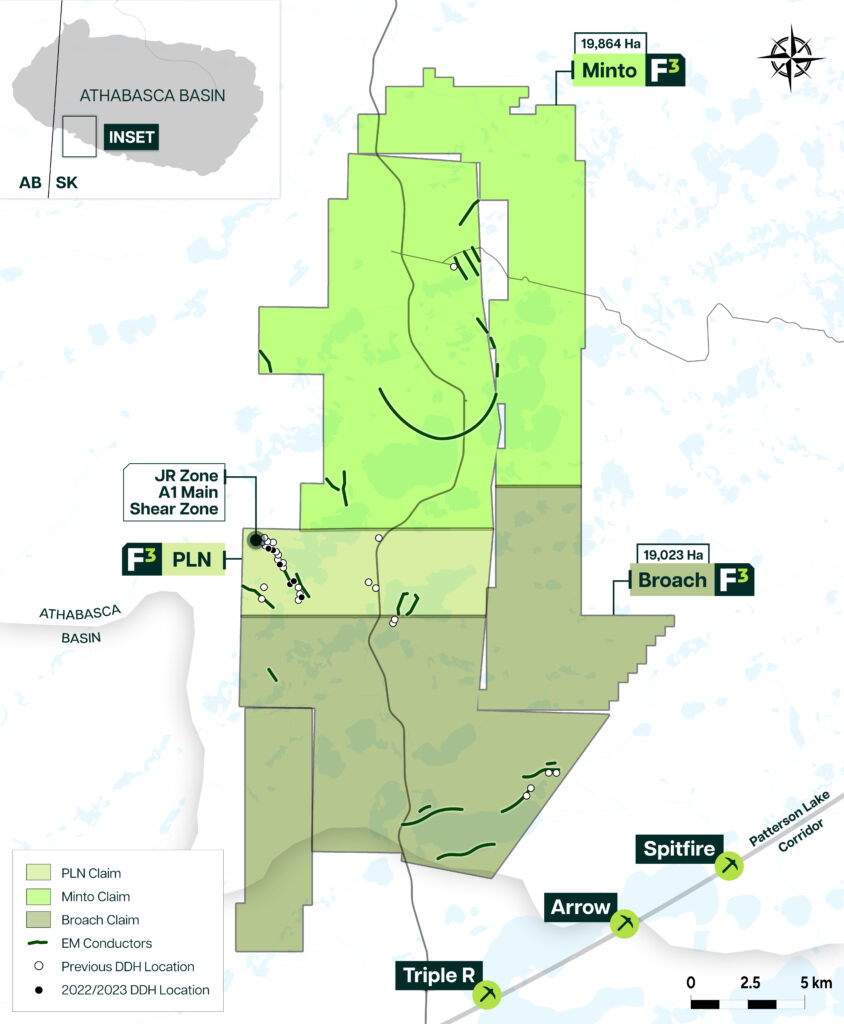F3 Uranium’s fall 2022 drilling program on the PLN property resulted in the discovery of the JR Zone with drill hole PLN22-035, which revealed off-scale radioactivity (>65,535 cps) and significant uraninite mineralization within the A1 main shear zone, including exceptionally high assays of U₃O₈. After the initial discovery, follow up drilling was aimed at extending and infilling uranium mineralization. Follow up drilling has expanded the JR Zone’s strike length to 156m and produced further high assays of up to 66.8% U₃O₈ (link to Feb 12th, 2024 news release) with the best hole drilled to date in terms of grade thickness with a true width assay interval of 4.5m of 50.1% U₃O₈ starting at a shallow depth of only 190m below surface. (link to December 3, 2024 news release).
In addition to the expansion of the JR zone, recent drilling has also focused on continuing exploration at PLN in search of additional mineralized zones. Much of the A1 Main Shear Zone that hosts the JR zone as well as the B1 conductor which runs parallel along the south end of A1 is unexplored, together with a strike length of 5km. A 30-hole winter 2024 drill program not only continued testing of the JR zone but also expanded exploration of A1 and B1. This exploration resulted in the intersection of a major reverse fault with offset in excess of 100m, which is believed to be the Harrison Fault and is cross cutting both the A1 and B1 shears. Exploration drilling was also highlighted by promising alteration, elevated boron and silicified brecciation in sandstone, with weakly anomalous radioactivity in both the A1 and B1 shears. (link to April 16th news release). Summer and Fall 2024 exploration drilling discovered the A1 Shear Extension beyond its previously interpreted southern extent where it becomes parallel to the B1 structures providing high priority drill targets for high grade uranium mineralization where the A1 and B1 structures are stacked (link to October 29, 2024 news release). Drilling at the JR Zone was focused on establishing continuity of its high grade core. This drilling was successful with strong mineralization being encountered in several holes, including the best hole drilled to date in terms of grade thickness at the JR Zone in drill hole PLN24-176, which returned a true width assay interval of 7.5m of 30.9% U₃O₈, including an ultra-high grade core of 4.5m of 50.1% U₃O₈. (link to December 3, 2024 news release).
In early July, F3 Uranium redefined the boundaries of the legacy PLN Property, splitting it into three distinct areas: PLN, Minto, and Broach. The restructuring focuses the PLN Property on two critical mineral claims, totaling 4,074 hectares, which include the entire 5 km-long A1 Main Shear Zone hosting the JR Zone and parallel B1 shear zone, underscoring its significance and potential for further uranium discoveries.

The JR Zone showcases strong levels of radioactivity, exceeding 65,535 counts per second (cps), highlighting an exceptional concentration of uraninite mineralization. Discovery hole PLN22-035 in the JR Zone intersected extremely radioactive pitchblende, with a 15.0 m section averaging 6.97% U3O8, including 5.5 m at 18.6% U₃O₈ and an ultra-high-grade core of 1.0 m at 59.2% U₃O₈. Since then, the JR zone has been expanded to 156m along strike with a maximum recorded assay grade of 66.8% over 0.5m. This remarkable find underscores the potential for additional significant uranium deposits on F3’s PLN property and adjacent Broach and Minto properties.
Legal | ©2026 F3 Uranium Corp.
Subscribe to stay updated
Stay up to date on our exciting new discoveries, what’s going on in the uranium space, and new opportunities developing in the Athabasca Basin
Dev Randhawa is a seasoned CEO with extensive experience in resources, mining exploration, and energy companies. As the former CEO of Fission Uranium Corp., Mr. Randhawa, along with his technical team, led the high-grade uranium discovery at PLS in 2012. Recently, Paladin Energy made an offer of $1.1 billion to buy Fission Uranium.
In 1996, Dev founded Strathmore Minerals Corp., leading it until 2008. Mr. Randhawa spun off Fission Energy Corp. in 2007, focusing on uranium exploration in Saskatchewan. He sold major assets to Denison Mines in 2013 for $85 million, creating Fission Uranium Corp.
Dev has executed significant joint ventures, including a $50 million partnership with Sumitomo (Japan) and $44mil with KEPCO (Korea). In 2016, Dev negotiated an $82 million investment in Fission from CGN Mining. He holds a BBA from Trinity Western College and an MBA from the University of British Columbia.